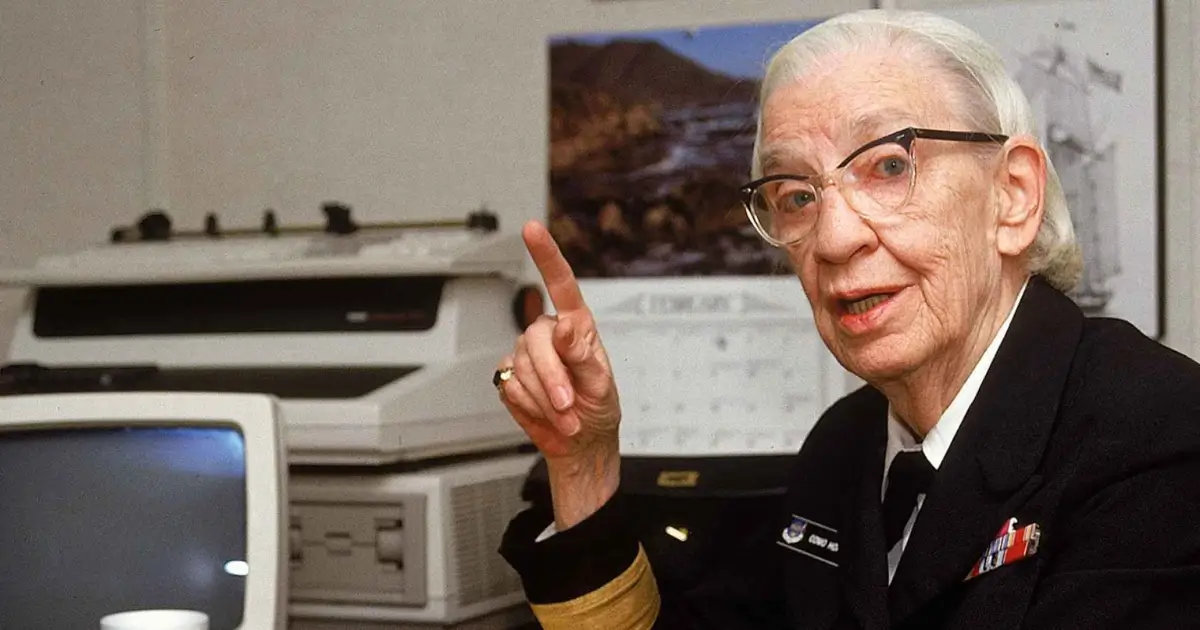Grace Hopper’s Enduring Lessons: 5 Insights for Tech Leaders
Join us as we uncover the legacy of Comodore Grace Murray Hopper, a pioneer in computer science and the development of the COBOL programming language. As we delve into her groundbreaking contributions and enduring lessons, we’ll explore the intersection of gender diversity and tech leadership.
Grace Hopper’s trailblazing work not only transformed computer technology but also championed innovation in software engineering. It also paved the way for greater inclusivity and innovation in the tech industry.
So… Who is Grace Hopper?
Grace Hopper, also known as “Amazing Grace,” a computer scientist and U.S. Navy rear admiral, forged a legacy that resonates through the field of computer science, influencing the development of computing systems.
She is most renowned for her groundbreaking work in computer programming languages, particularly the development of COBOL, one of the first high-level programming languages.
It only takes a few minutes of her CBS 60 Minutes’ special to fully perceive her ability to simplify knowledge and communicate thoroughly:
Eager for further insights? Delve into her life story through the biography by Kurt W. Bayer, exploring her impact on computer science and data processing.
Little-Known Facts about Grace Hopper
Grace Hopper’s contributions extended beyond her technical achievements. She was a trailblazer for women in male-dominated fields, earning numerous accolades and honors throughout her career. Despite facing adversity, she remained dedicated to her work and inspired countless individuals to pursue careers in technology.
- Educational Legacy: Hopper was a passionate advocate for education, traveling the world to educate others on the use of compilers and computer language standardization.
- Recognition and Awards: She received over 40 honorary doctoral degrees and was the first woman to receive the Computer Science Man-of-the-Year Award.
- Lasting Impact: Hopper’s work laid the foundation for modern programming languages and user-friendly computing devices, shaping the digital landscape for generations to come.
Want to check out our commented version? Tune in to our podcast episode dedicated to this tech legend:
Timeless Lessons for Tech Leaders
So what did Grace Hopper, the pioneer of computer programming, teach us that still holds true? Here are seven insights drawn from her remarkable career that still hold true for tech leaders today:
Lesson 1: Innovate and Challenge Tradition
Grace Hopper famously declared, “Probably the most dangerous phrase you could ever use in any computer installation is that dreadful one: ‘but we’ve always done it that way.’” This bold stance on innovation underscores the importance of challenging traditional methods and embracing change in tech development.
Looking for inspiration? Watch her landmark 1985 guest lecture at MIT.
Lesson 2: Communicate Clearly and Effectively
Grace Hopper also emphasized the need for plain language in technical communication. “I would urge all of you please to write more stuff in plain English so we can feed it to admirals and generals and people like that. They don’t understand ‘computerezze’, they need plain English, and we have got to convert them in one way or another.”
She consistently urged tech professionals to write in plain English to bridge the gap between technical concepts and non-technical stakeholders, highlighting the importance of soft skills in driving successful projects.
Sidenote: if you agree, you may want to check our Most Desirable Behavioural Skills to Look for in Tech Pros article.
Lesson 3: Advocate for User-Centric Design in Software Engineering (Including Internal Stakeholders)
Hopper’s work in developing Common Business-Oriented Language (COBOL), a user-friendly programming language, underscored the importance of real-time responsiveness in information systems, without compromising user-centric design. Tech leaders can learn from her emphasis on creating tools and systems that prioritize user experience and accessibility.
The Flow-Matic compiler that Grace Hopper created laid the groundwork for the language by providing essential foundations. Additionally, she crafted standard manuals, tools, and translator programs to ensure the smooth adoption and implementation of COBOL across various systems. As a result, the initial specifications for COBOL became accessible in 1959, marking a significant milestone in the evolution of computer programming languages.
Grace Hopper’s creation revolutionized IT and the world by enabling humans to communicate with computers using natural language instead of complex binary code. This innovation made computer programming more accessible to a wider audience, accelerating the development of software applications and significantly advancing the digital era.
Lesson 4: Foster Optimism and Mentorship for the Next Generation in Software Engineering
Despite not witnessing the full wonders of the internet age before her passing in 1992, Hopper’s optimism shines through her words from a lecture at the University of Tennessee in 1983. Reflecting on the evolving landscape of technology, Hopper highlighted anecdotes of children effortlessly navigating computers, teaching their parents in the process.
Grace Hopper’s optimism shines through her words: “those youngsters are terrific… we’ve got to provide the support for them and the leadership for them which they richly deserve.” Her belief in the potential of the future generation resonates deeply.
In her view, young people held immense potential, and it was the responsibility of leaders to provide them with the necessary support and guidance to thrive. By instilling a sense of optimism and fostering an environment conducive to learning and innovation, tech leaders can ensure that future generations continue to push the boundaries of what is possible in the digital age.
Lesson 5: Gender Diversity Drives Innovation
Grace Hopper’s success in computer science, a traditionally male-dominated domain, underscores the importance of gender diversity in tech. By breaking barriers and advocating for inclusion, she paved the way for high-performing teams that benefit from diverse perspectives and experiences.
However, recent statistics reveal ongoing disparities:
- Only 33% of the workforce at large tech companies are women (Deloitte), with a minimal increase of less than 1% in 2022 (Anitab)
- Shockingly, 50% of women in tech leave their jobs by age 35 (Accenture)
- The average salary for women in tech trails behind men by over $15,000 (CIO)
Imagine the strides we could make with greater gender diversity in tech. By recognizing the female presence and the importance of diverse teams, founders and decision-makers are invited to proactively integrate more women into their teams.
Doing so not only fosters inclusivity but also leads to enhanced user experiences, as diverse teams bring forth a range of perspectives and experiences, ultimately driving innovation and progress in the tech industry.
Embracing Grace Hopper’s Legacy (aka How to Have more Female Geniuses in Your Software Teams)
Grace Hopper’s enduring wisdom continues to inspire us to build diverse and resilient software teams. By following her example and prioritizing inclusivity, we can create innovative solutions that reflect the diverse needs of our global community.
Address Gender Bias in Recruitment
To attract and retain top talent in computer science, tech companies must combat gender bias in recruitment practices. Using gender-aware recruitment specialists and inclusive job descriptions can help mitigate bias and create a more diverse and inclusive workforce.
Foster Collaboration and Mentorship
Throughout her career, Grace Hopper championed collaboration and mentorship, recognizing the importance of sharing knowledge and empowering the next generation of tech talent. By promoting a culture of collaboration and mentorship, tech leaders can build resilient teams that thrive in dynamic environments.
Embrace Distributed Teams for Work-Life Balance
In today’s globalized world, distributed teams offer flexibility and access to a diverse talent pool. By embracing distributed teams and paying attention to work-life balance, tech leaders can create environments where all team members can thrive and contribute to the success of the organization.
We also have other sources you may want to check out:
- Who Are the Female CTOs That Are Transforming SaaS in LatAm
- Go-to Tips and Career Advice for Women in IT
- If Books Could Kill Podcast: Lean In Episode
Ready to build a diverse and high-performing tech team? Contact Ubiminds today to learn more about our talent-as-a-service solutions and how we can help you access top female talent in Latin America without risk or hassle.
FAQ

International Marketing Leader, specialized in tech. Proud to have built marketing and business generation structures for some of the fastest-growing SaaS companies on both sides of the Atlantic (UK, DACH, Iberia, LatAm, and NorthAm). Big fan of motherhood, world music, marketing, and backpacking. A little bit nerdy too!








